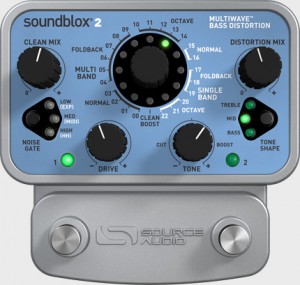Pedal Review: Source Audio Soundblox 2 Multiwave Bass Distortion
Delicious Audio recently did a short review of Source Audio’s Soundblox 2 Multiwave Bass Distortion pedal. Click to read the review in its entirety, and see an excerpt below…
The bass guitar can be one of the trickiest instruments to record. This may be because of several factors, but one of the more common reasons is that low-end instruments like the bass guitar sit in a very awkward place in the frequency spectrum. The low end is said to be one of the hardest areas to get tight in a mix: things tend to get muddy and lethargic in a hurry down there. Throw some distortion into the mix and you’ve just made things a bit harder.
There are certain songs that would simply not be the same without that distorted bass line like The Beastie Boys’ Sabotage. In order to obtain this sort of distortion you would most likely have to use a pedal designed for guitar or try one of the gimmicky “bass distortion” pedals out there.
What Source Audio is aiming to do with the Soundblox 2 pedal is to offer the ultimate bass distortion stomp box by providing many different types of bass distortion in one pedal while implementing technology (multiband distortion) that would only be available in the digital domain.
I like this a lot in theory, but how does it do in practice?
Starting with the Interface
So we’ve got 5 knobs, 2 muti-purpose buttons, and two footswitches with green status indicators. The Clean Mix knob introduces the amount of unaffected dry signal into the path. The Distortion Mix knob controls the amount of distorted signal that is then mixed with the clean signal to give us our final mix at the Guitar Out port. I like that you have control over both mixes here. It allows you the flexibility needed to make a proper bass distortion tone. The big knob in the middle is the Distortion Mode knob. Its function is to let you select which type of distortion you’d like use. The two main categories are multiband mode and single mode.
The multiband mode breaks the incoming signal down into multiple frequency bands so that distortion can be applied to different bands equally. In theory this would provide for a much more well rounded distortion tone, but I feel the result is not what I expected. Rather than the tones sounding much more natural and well rounded, I found them to sound artificial and super synthy sounding. The single band sounds are supposed to be the more traditional distortion tones characteristic of the distortion pedals of old. I actually thought these sounded better overall. Maybe I am an old school kind of guy?
Click here to read the rest of the review, by Gus Green.
Please note: When you buy products through links on this page, we may earn an affiliate commission.







